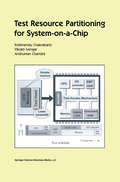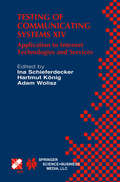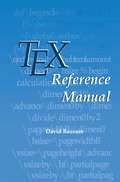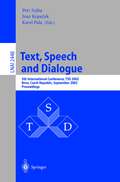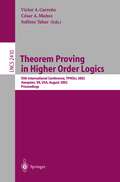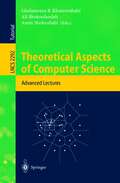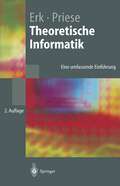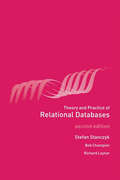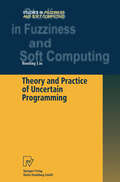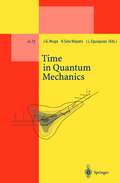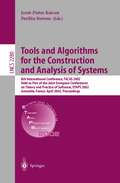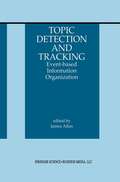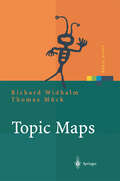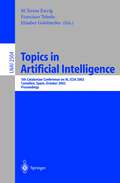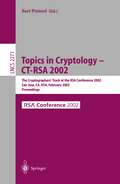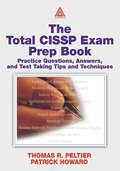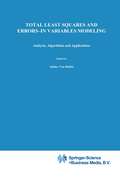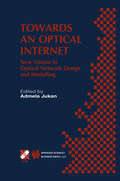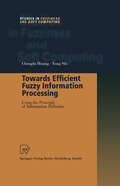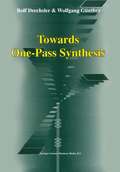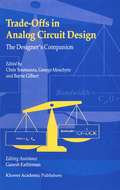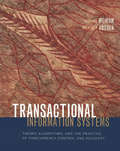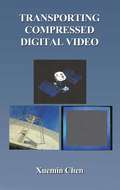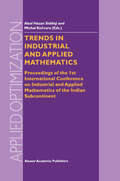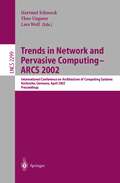- Table View
- List View
Test Resource Partitioning for System-on-a-Chip (Frontiers in Electronic Testing #20)
by Vikram Iyengar Anshuman ChandraTest Resource Partitioning for System-on-a-Chip is about test resource partitioning and optimization techniques for plug-and-play system-on-a-chip (SOC) test automation. Plug-and-play refers to the paradigm in which core-to-core interfaces as well as core-to-SOC logic interfaces are standardized, such that cores can be easily plugged into "virtual sockets" on the SOC design, and core tests can be plugged into the SOC during test without substantial effort on the part of the system integrator. The goal of the book is to position test resource partitioning in the context of SOC test automation, as well as to generate interest and motivate research on this important topic. SOC integrated circuits composed of embedded cores are now commonplace. Nevertheless, There remain several roadblocks to rapid and efficient system integration. Test development is seen as a major bottleneck in SOC design, and test challenges are a major contributor to the widening gap between design capability and manufacturing capacity. Testing SOCs is especially challenging in the absence of standardized test structures, test automation tools, and test protocols. Test Resource Partitioning for System-on-a-Chip responds to a pressing need for a structured methodology for SOC test automation. It presents new techniques for the partitioning and optimization of the three major SOC test resources: test hardware, testing time and test data volume. Test Resource Partitioning for System-on-a-Chip paves the way for a powerful integrated framework to automate the test flow for a large number of cores in an SOC in a plug-and-play fashion. The framework presented allows the system integrator to reduce test cost and meet short time-to-market requirements.
Testing of Communicating Systems XIV: Application to Internet Technologies and Services (IFIP Advances in Information and Communication Technology #82)
by Ina Schieferdecker Hartmut König Adam WoliszTesting of Communicating Systems XIV presents the latest international results in both the theory and industrial practice of the testing of communicating systems, ranging from tools and techniques for testing to test standards, frameworks, notations, algorithms, fundamentals of testing, and industrial experiences and issues. The tools and techniques discussed apply to conformance testing, interoperability testing, performance testing, Internet protocols and applications, and multimedia and distributed systems in general.
Text, Speech and Dialogue: 5th International Conference, TSD 2002, Brno, Czech Republic September 9-12, 2002. Proceedings (Lecture Notes in Computer Science #2448)
by Petr Sojka Ivan Kopecek Karel PalaThe Text, Speech and Dialogue (TSD) Conference 2002, it should be noticed, is now being held for the ?fth time and we are pleased to observe that in its short history it has turned out to be an international forum successfully intertwining the basic ?elds of NLP. It is our strong hope that the conference contributes to a better understanding between researchers from the various areas and promotes more intensive mutual cooperation. So far the communication between man and computers has displayed a one-way nature, humans have to know how the - chines work and only then can they “understand” them. The opposite, however, is still quite far from being real, our understanding of how our “user-friendly” computers can understand us humans is not deep enough yet. A lot of work has to be done both in the near and distant future. Let TSD 2002 be a modest contribution to this goal. The conference also serves well in its second purpose: to facilitate researchers meeting in the NLP ?eld from Western and Eastern Europe. Moreover, many participants now come from other parts of the world, thus making TSD a real crossroadsforresearchersintheNLParea. Thisvolumecontainstheproceedings of this conference held in Brno, September 9–12, 2002. We were honored to have as keynote speakers James Pustejovsky from Brandeis University, and Ronald Cole from the University of Colorado. We would like to thank all the Program Committee members and external reviewers for their conscientious and diligent reviewing work.
Theorem Proving in Higher Order Logics: 15th International Conference, TPHOLs 2002, Hampton, VA, USA, August 20-23, 2002. Proceedings (Lecture Notes in Computer Science #2410)
by Victor A. Carreno Cesar A. Munoz Sofiene TaharTheoretical Aspects of Computer Science: Advanced Lectures (Lecture Notes in Computer Science #2292)
by Gholamreza B. Khosrovshahi Ali Shokoufandeh Amin ShokrollahiTheoretische Informatik: Eine umfassende Einführung (Springer-Lehrbuch)
by Katrin Erk Lutz PrieseDiese Einführung in die Theoretische Informatik zeichnet sich durch Verständlichkeit und gute Lesbarkeit aus. Sie umfaßt die Theorie der formalen Sprachen, die Theorie der Berechenbarkeit und einen Überblick über die Komplexitätstheorie. Das Buch eignet sich insbesondere für Anfänger: Alle Beweise sind im Detail ausgeführt - insofern ist es auch eine Einführung in die Technik des Beweisens. Für Dozenten ist das Buch ebenfalls interessant, da die Beweise nicht nur wie vielfach üblich skizziert sind und auch Nicht-Standard-Berechnungsmodelle vorgestellt werden.Das Buch basiert auf Vorlesungen der letzten zehn Jahre für Studierende der Informatik im Grundstudium an den Universitäten Paderborn und Koblenz.Die Neuauflage wurde um theoretische Grundlagen für Quantenrechner ergänzt.
Theory and Practice of Relational Databases
by Stefan Stanczyk Bob Champion Richard LeytonThe study of relationship databases is a core component of virtually every undergraduate computer science degree course. This new edition of Theory and Practice of Relationship Databases retains all the features that made the previous edition such as success, and goes on to give even more comprehensive and informative coverage.Written in a tutorial style and containing a great many examples and exercises as well as extensively using illustrative and explanatory graphics, the author has produced an undergraduate textbook of great depth and clarity that is very easy to follow. The subject of relational databases is brought to life by the writing style and the inclusion of an homogenous case study that reinforces the issues dealt with in each chapter.The primary objective of the book is to present a comprehensive explanation of the process of development of database application systems within the framework of a set processing paradigm. Since the majority of these applications are built as relationship systems, a complete though reasonably concise account of that model is presented. Dr. Stanczyk has achieved this by concentrating on the issues that contribute significantly to the application development while de-emphasizing purely theoretical aspects of the subject. This has led to an imaginative and highly practical textbook that will be an excellent read for the undergraduate computer science student.
Theory and Practice of Uncertain Programming (Studies in Fuzziness and Soft Computing #102)
by Baoding LiuReal-life decisions are usually made in the state of uncertainty (randomness, fuzziness, roughness, etc.). How do we model optimization problems in uncertain environments? How do we solve these models? In order to answer these questions, this book provides a self-contained, comprehensive and up-to-date presentation of uncertain programming theory. It includes numerous modeling ideas, hybrid intelligent algorithms, and various applications in transportation problem, inventory system, facility location & allocation, capital budgeting, topological optimization, vehicle routing problem, redundancy optimization, and scheduling. Researchers, practitioners and students in operations research, management science, information science, system science, and engineering will find this work a stimulating and useful reference.
Time in Quantum Mechanics (Lecture Notes in Physics Monographs #72)
by J. G. Muga R. Sala Mayato I. L. EgusquizaTime and quantum mechanics have, each of them separately, captivated s- entists and laymen alike, as shown by the abundance of popular publications on “time” or on the many quantum mysteries or paradoxes. We too have been seduced by these two topics, and in particular by their combination. Indeed, the treatment of time in quantum mechanics is one of the important and challenging open questions in the foundations of quantum theory. This book describes the problems, and the attempts and achievements in de?ning, formalizing and measuring di?erent time quantities in quantum theory, such as the parametric (clock) time, tunneling times, decay times, dwell times, delay times, arrival times or jump times. The theoretical analysis of several of these quantities has been controversial and is still subject to debate. For example, there are literally hundreds of research papers on the tunneling time. In fact, the standard recipe to link the observables and the formalism does not seem to apply, at least in an obvious manner, to time observables. This has posed the challenge of extending the domain of ordinary quantum mechanics.
Tools and Algorithms for the Construction and Analysis of Systems: 8th International Conference, TACAS 2002, Held as Part of the Joint European Conferences on Theory and Practice of Software, ETAPS 2002, Grenoble, France, April 8-12, 2002. Proceedings (Lecture Notes in Computer Science #2280)
by Joost-Pieter Katoen Perdita StevensETAPS 2002 was the ?fth instance of the European Joint Conferences on Theory and Practice of Software. ETAPS is an annual federated conference that was established in 1998by combining a number of existing and new conferences. This year it comprised 5 conferences (FOSSACS, FASE, ESOP, CC, TACAS), 13 satellite workshops (ACL2, AGT, CMCS, COCV, DCC, INT, LDTA, SC, SFEDL, SLAP, SPIN, TPTS, and VISS), 8invited lectures (not including those speci?c to the satellite events), and several tutorials. The events that comprise ETAPS address various aspects of the system - velopment process, including speci?cation, design, implementation, analysis, and improvement. The languages, methodologies, and tools which support these - tivities are all well within its scope. Di?erent blends of theory and practice are represented, with an inclination towards theory with a practical motivation on one hand and soundly-based practice on the other. Many of the issues involved in software design apply to systems in general, including hardware systems, and the emphasis on software is not intended to be exclusive.
Topic Detection and Tracking: Event-based Information Organization (The Information Retrieval Series #12)
by James AllanTopics in Artificial Intelligence: 5th Catalonian Conference on AI, CCIA 2002, Castellón, Spain, October 24-25, 2002. Proceedings (Lecture Notes in Computer Science #2504)
by Maria Teresa Escrig Monferrer Francisco Toledo Lobo Elisabet Golobardes I RibéThis book constitutes the refereed proceedings of the 5th Catalonian Conference on Artificial Intelligence, CCIA 2002, held in Castellón, Spain in October 2002.The 37 revised full papers presented were carefully reviewed and selected from 77 submissions. The papers are organized in topical sections on reasoning models, constraint satisfation, machine learning and classification, multi-agent systems, and computer vision and robotics.
Topics in Cryptology - CT-RSA 2002: The Cryptographer's Track at the RSA Conference 2002, San Jose, CA, USA, February 18-22, 2002, Proceedings (Lecture Notes in Computer Science #2271)
by Bart PreneelThis volume continues the tradition established in 2001 of publishing the c- tributions presented at the Cryptographers’ Track (CT-RSA) of the yearly RSA Security Conference in Springer-Verlag’s Lecture Notes in Computer Science series. With 14 parallel tracks and many thousands of participants, the RSA - curity Conference is the largest e-security and cryptography conference. In this setting, the Cryptographers’ Track presents the latest scienti?c developments. The program committee considered 49 papers and selected 20 for presen- tion. One paper was withdrawn by the authors. The program also included two invited talks by Ron Rivest (“Micropayments Revisited” – joint work with Silvio Micali) and by Victor Shoup (“The Bumpy Road from Cryptographic Theory to Practice”). Each paper was reviewed by at least three program committee members; paperswrittenbyprogramcommitteemembersreceivedsixreviews.Theauthors of accepted papers made a substantial e?ort to take into account the comments intheversionsubmittedtotheseproceedings.Inalimitednumberofcases,these revisions were checked by members of the program committee. I would like to thank the 20 members of the program committee who helped to maintain the rigorous scienti?c standards to which the Cryptographers’ Track aims to adhere. They wrote thoughtful reviews and contributed to long disc- sions; more than 400 Kbyte of comments were accumulated. Many of them - tended the program committee meeting, while they could have been enjoying the sunny beaches of Santa Barbara.
The Total CISSP Exam Prep Book: Practice Questions, Answers, and Test Taking Tips and Techniques
by Thomas R. Peltier Patrick D. Howard Bob CartwrightUntil now, those preparing to take the Certified Information Systems Security Professional (CISSP) examination were not afforded the luxury of studying a single, easy-to-use manual. Written by ten subject matter experts (SMEs) - all CISSPs - this test prep book allows CISSP candidates to test their current knowledge in each of the ten security doma
Total Least Squares and Errors-in-Variables Modeling: Analysis, Algorithms and Applications
by S. Van Huffel P. LemmerlingIn response to a growing interest in Total Least Squares (TLS) and Errors-In-Variables (EIV) modeling by researchers and practitioners, well-known experts from several disciplines were invited to prepare an overview paper and present it at the third international workshop on TLS and EIV modeling held in Leuven, Belgium, August 27-29, 2001. These invited papers, representing two-thirds of the book, together with a selection of other presented contributions yield a complete overview of the main scientific achievements since 1996 in TLS and Errors-In-Variables modeling. In this way, the book nicely completes two earlier books on TLS (SIAM 1991 and 1997). Not only computational issues, but also statistical, numerical, algebraic properties are described, as well as many new generalizations and applications. Being aware of the growing interest in these techniques, it is a strong belief that this book will aid and stimulate users to apply the new techniques and models correctly to their own practical problems.
Towards an Optical Internet: New Visions in Optical Network Design and Modelling. IFIP TC6 Fifth Working Conference on Optical Network Design and Modelling (ONDM 2001) February 5–7, 2001, Vienna, Austria (IFIP Advances in Information and Communication Technology #76)
by Admela JukanIn these exciting times of quotidianly progressing developments in communication techniques, where more than ever in the history of a technological progress, society's reliance on communication networks for medicine, education, data transfer, commerce, and many other endeavours dominates the human's everyday life, the optical networks are certainly one of the most promising and challenging networking options. Since their commercial arrival in the nineties, they have fundamentally changed the way of dealing with traffic engineering by removing bandwidth bottlenecks and eliminating delays. Today, after the revolutionary bandwidth expansion, the networking functionality migrates more and more to the optical layer, and the need to establish fast wavelength circuits and capacity-on-demand for the higher-layer networks, in particular data networks based on Internet Protocol (IP), has become one of the central networking issues for the new century. The unifying trends toward configurable all-optical network infrastructure open up a wide range of new network engineering and design choices dealing with networks' interoperability and common platforms for control and management. The Fifth Working Conference on Optical Network Design and Modelling, held in the Austrian capital Vienna, February 5-7, 2001, aims at presenting the most recent progress in optical communication techniques, new technologies, standardisation process, emerging markets and carriers. A short look at the Table of Contents of this book tells us, in fact, that this year's conference program reflects the current state of the art precisely.
Towards Efficient Fuzzy Information Processing: Using the Principle of Information Diffusion (Studies in Fuzziness and Soft Computing #99)
by Chongfu Huang Yong ShiWhen we learn from books or daily experience, we make associations and draw inferences on the basis of information that is insufficient for under standing. One example of insufficient information may be a small sample derived from observing experiments. With this perspective, the need for de veloping a better understanding of the behavior of a small sample presents a problem that is far beyond purely academic importance. During the past 15 years considerable progress has been achieved in the study of this issue in China. One distinguished result is the principle of in formation diffusion. According to this principle, it is possible to partly fill gaps caused by incomplete information by changing crisp observations into fuzzy sets so that one can improve the recognition of relationships between input and output. The principle of information diffusion has been proven suc cessful for the estimation of a probability density function. Many successful applications reflect the advantages of this new approach. It also supports an argument that fuzzy set theory can be used not only in "soft" science where some subjective adjustment is necessary, but also in "hard" science where all data are recorded.
Towards One-Pass Synthesis
by Rolf Drechsler Wolfgang GüntherThe design process of digital circuits is often carried out in individual steps, like logic synthesis, mapping, and routing. Since originally the complete process was too complex, it has been split up in several - more or less independen- phases. In the last 40 years powerful algorithms have been developed to find optimal solutions for each of these steps. However, the interaction of these different algorithms has not been considered for a long time. This leads to quality loss e. g. in cases where highly optimized netlists fit badly onto the target architecture. Since the resulting circuits are often far from being optimal and insufficient regarding the optimization criteria, like area and delay, several iterations of the complete design process have to be carried out to get high quality results. This is a very time consuming and costly process. For this reason, some years ago the idea of one-pass synthesis came up. There were two main approaches how to guarantee that a design got "first time right" : 1. Combining levels that were split before, e. g. to use layout information already during the logic synthesis phase. 2. Restricting the optimization in one level such that it better fits to the next one. So far, several approaches in these two directions have been presented and new techniques are under development. In this book we describe the new paradigm that is used in one-pass synthesis and present examples for the two techniques above.
Trade-Offs in Analog Circuit Design: The Designer's Companion
by Chris Toumazou George S. Moschytz Barrie GilbertAs the frequency of communication systems increases and the dimensions of transistors are reduced, more and more stringent performance requirements are placed on analog circuits. This is a trend that is bound to continue for the foreseeable future and while it does, understanding performance trade-offs will constitute a vital part of the analog design process. It is the insight and intuition obtained from a fundamental understanding of performance conflicts and trade-offs, that ultimately provides the designer with the basic tools necessary for effective and creative analog design. Trade-offs in Analog Circuit Design, which is devoted to the understanding of trade-offs in analog design, is quite unique in that it draws together fundamental material from, and identifies interrelationships within, a number of key analog circuits. The book covers ten subject areas: Design methodology, Technology, General Performance, Filters, Switched Circuits, Oscillators, Data Converters, Transceivers, Neural Processing, and Analog CAD. Within these subject areas it deals with a wide diversity of trade-offs ranging from frequency-dynamic range and power, gain-bandwidth, speed-dynamic range and phase noise, to tradeoffs in design for manufacture and IC layout. The book has by far transcended its original scope and has become both a designer's companion as well as a graduate textbook. An important feature of this book is that it promotes an intuitive approach to understanding analog circuits by explaining fundamental relationships and, in many cases, providing practical illustrative examples to demonstrate the inherent basic interrelationships and trade-offs. Trade-offs in Analog Circuit Design draws together 34 contributions from some of the world's most eminent analog circuits-and-systems designers to provide, for the first time, a comprehensive text devoted to a very important and timely approach to analog circuit design.
Transactional Information Systems: Theory, Algorithms, and the Practice of Concurrency Control and Recovery (The Morgan Kaufmann Series in Data Management Systems)
by Gerhard Weikum Gottfried VossenTransactional Information Systems is the long-awaited, comprehensive work from leading scientists in the transaction processing field. Weikum and Vossen begin with a broad look at the role of transactional technology in today's economic and scientific endeavors, then delve into critical issues faced by all practitioners, presenting today's most effective techniques for controlling concurrent access by multiple clients, recovering from system failures, and coordinating distributed transactions. The authors emphasize formal models that are easily applied across fields, that promise to remain valid as current technologies evolve, and that lend themselves to generalization and extension in the development of new classes of network-centric, functionally rich applications. This book's purpose and achievement is the presentation of the foundations of transactional systems as well as the practical aspects of the field what will help you meet today's challenges.Provides the most advanced coverage of the topic available anywhere--along with the database background required for you to make full use of this material.Explores transaction processing both generically as a broadly applicable set of information technology practices and specifically as a group of techniques for meeting the goals of your enterprise.Contains information essential to developers of Web-based e-Commerce functionality--and a wide range of more "traditional" applications.Details the algorithms underlying core transaction processing functionality.
Transporting Compressed Digital Video (The Springer International Series in Engineering and Computer Science #674)
by Xuemin ChenThe purpose of Transporting Compressed Digital Video is to introduce fundamental principles and important technologies used in design and analysis of video transport systems for many video applications in digital networks. In the past two decades, progress in digital video processing, transmission, and storage technologies, such as video compression, digital modulation, and digital storage disk, has proceeded at an astounding pace. Digital video compression is a field in which fundamental technologies were motivated and driven by practical applications so that they often lead to many useful advances. Especially, the digital video-compression standards, developed by the Moving Pictures Expert Group (MPEG) of the International Organization for Standardization (ISO) and the International Electrotechnical Commission (IEC), have enabled many successful digital-video applications. These applications range from digital-video disk (DVD) and multimedia CDs on a desktop computer, interactive digital cable television, to digital satellite networks. MPEG has become the most recognized standard for digital video compression. MPEG video is now an integral part of most digital video transmission and storage systems. Nowadays, video compression technologies are being used in almost all modern digital video systems and networks. Not only is video compression equipment being implemented to increase the bandwidth efficiency of communication systems, but video compression also provides innovative solutions to many related vid- networking problems. The subject of Transporting Compressed Digital Video includes several important topics, in particular video buffering, packet scheduling, multiplxing and synchronization.
Trends in Industrial and Applied Mathematics: Proceedings of the 1st International Conference on Industrial and Applied Mathematics of the Indian Subcontinent (Applied Optimization #72)
by Abul Hasan Siddiqi M. KocvaraAn important objective of the study of mathematics is to analyze and visualize phenomena of nature and real world problems for its proper understanding. Gradually, it is also becoming the language of modem financial instruments. To project some of these developments, the conference was planned under the joint auspices of the Indian Society of Industrial and Applied mathematics (ISlAM) and Guru Nanak Dev University (G. N. D. U. ), Amritsar, India. Dr. Pammy Manchanda, chairperson of Mathematics Department, G. N. D. U. , was appointed the organizing secretary and an organizing committee was constituted. The Conference was scheduled in World Mathematics Year 2000 but, due one reason or the other, it could be held during 22. -25. January 2001. How ever, keeping in view the suggestion of the International Mathematics union, we organized two symposia, Role of Mathematics in industrial development and vice-versa and How image of Mathematics can be improved in public. These two symposia aroused great interest among the participants and almost everyone participated in the deliberations. The discussion in these two themes could be summarized in the lengthy following lines: "Tradition of working in isolation is a barrier for interaction with the workers in the other fields of science and engineering, what to talk of non-academic areas, specially the private sector of finance and industry. Therefore, it is essential to build bridges within in stitutions and between institutions.
